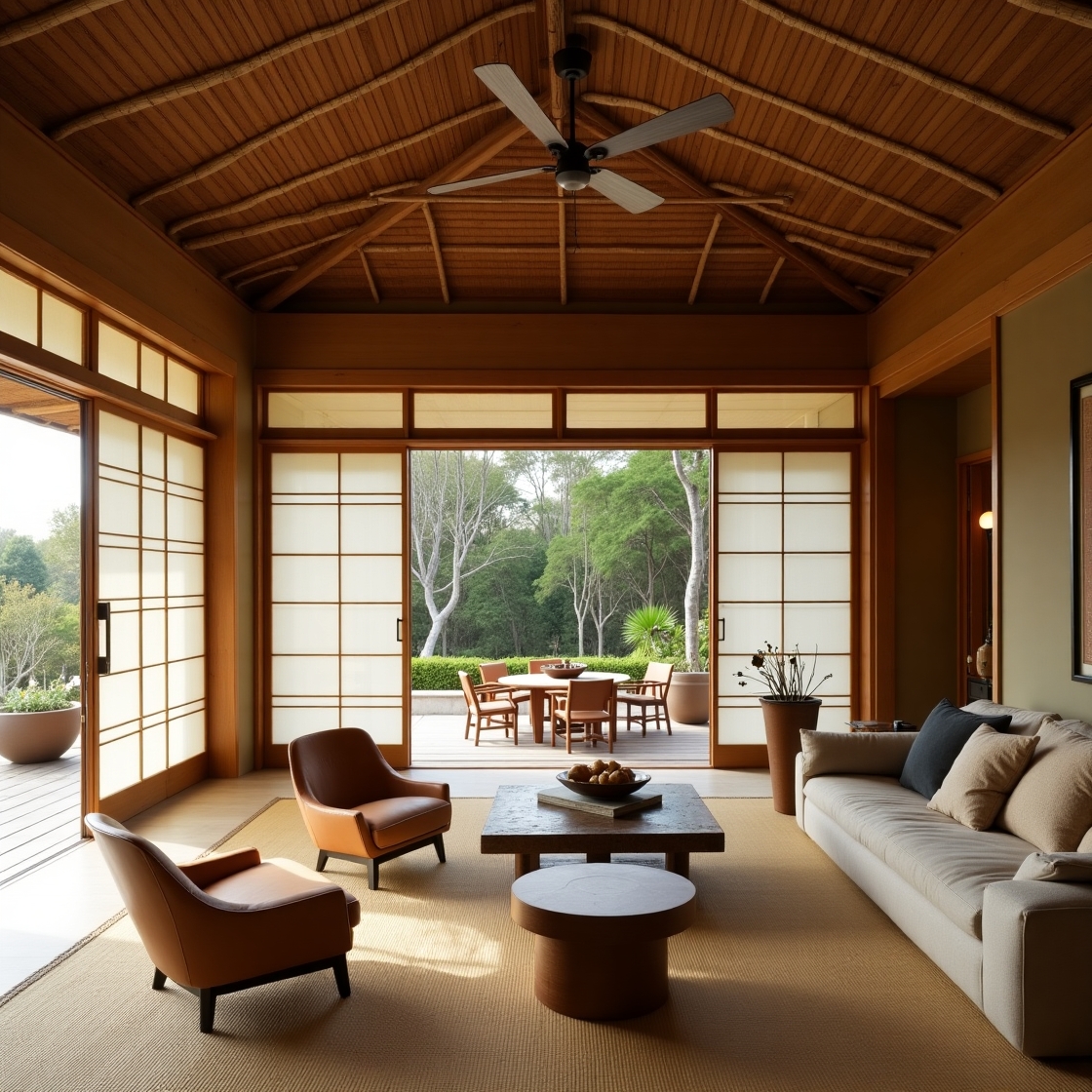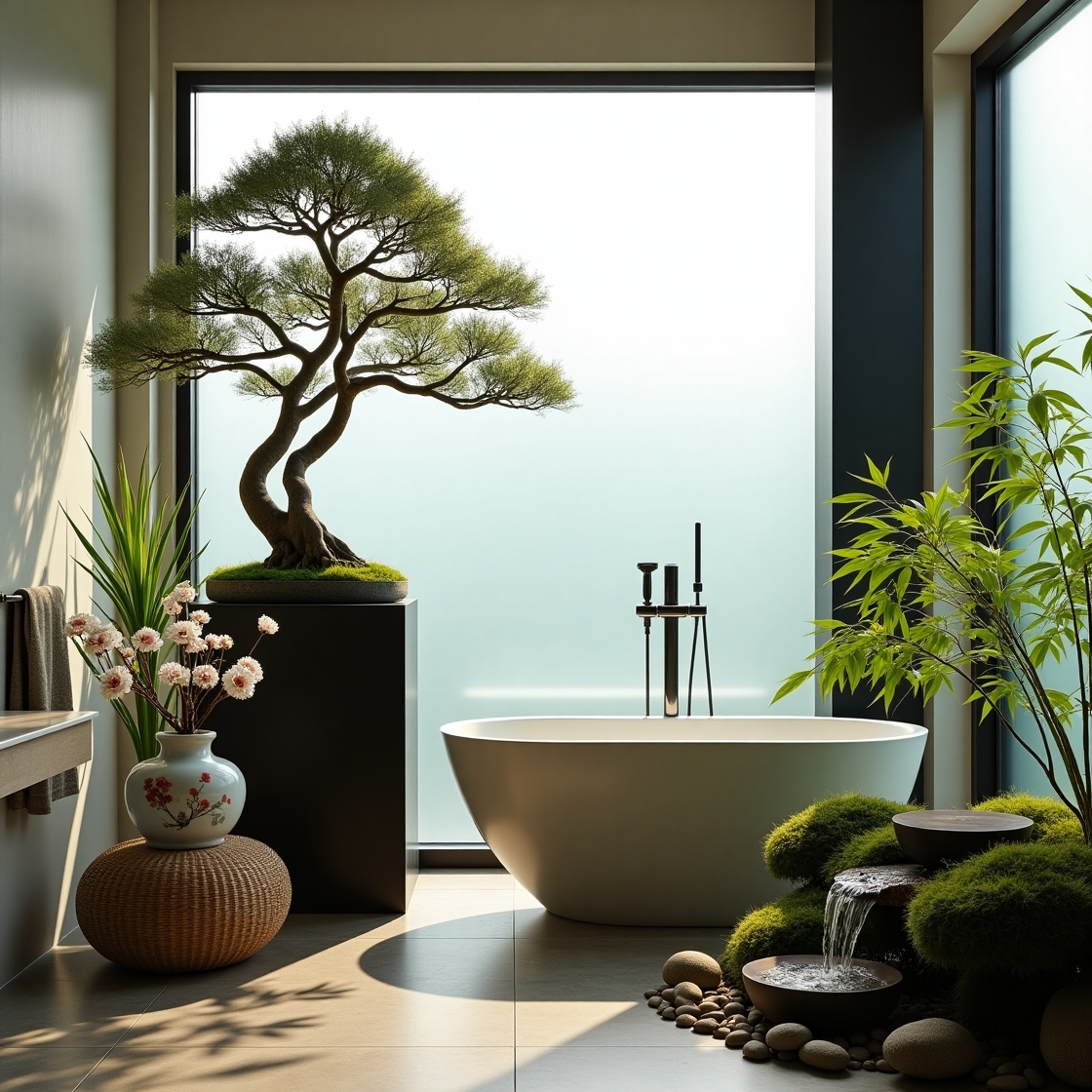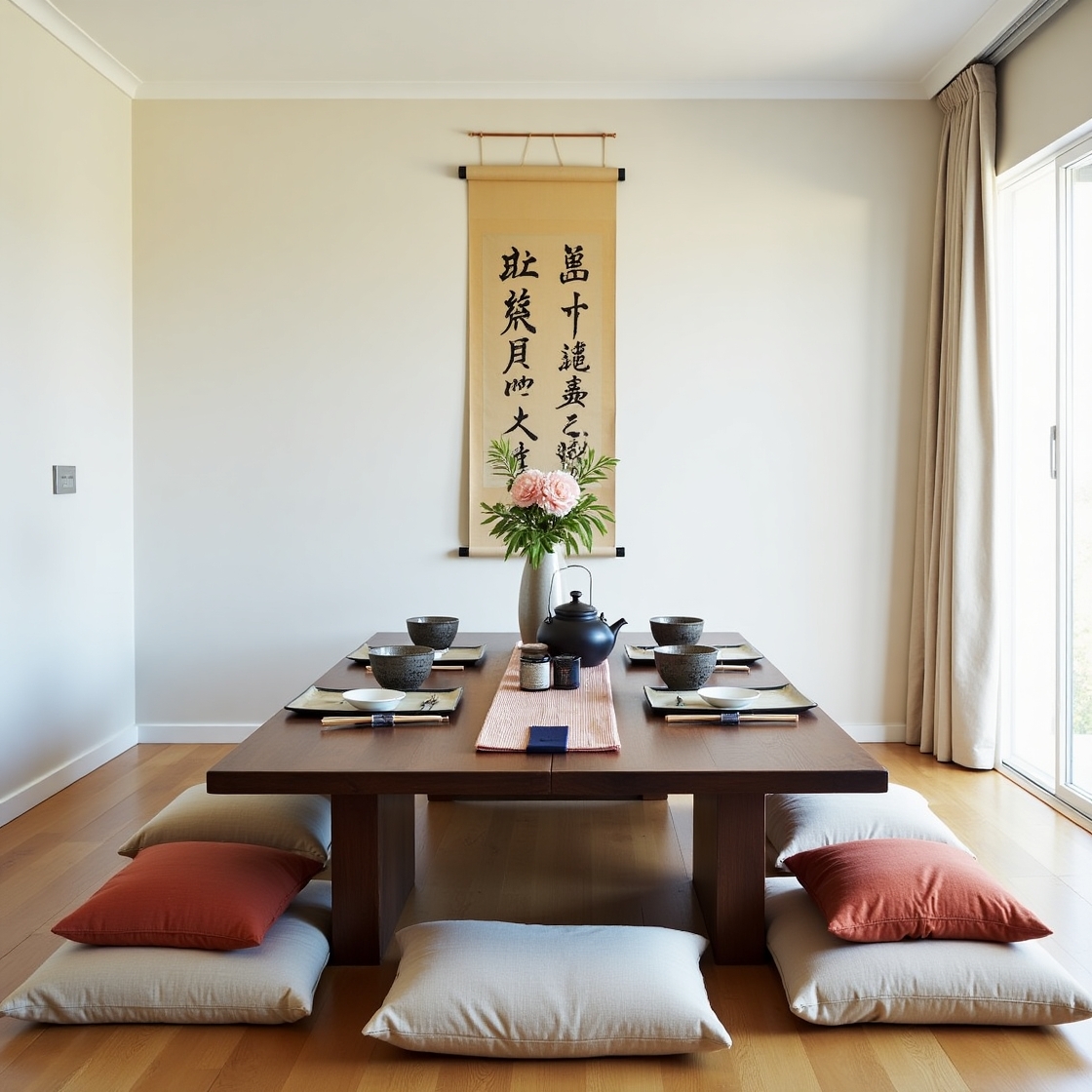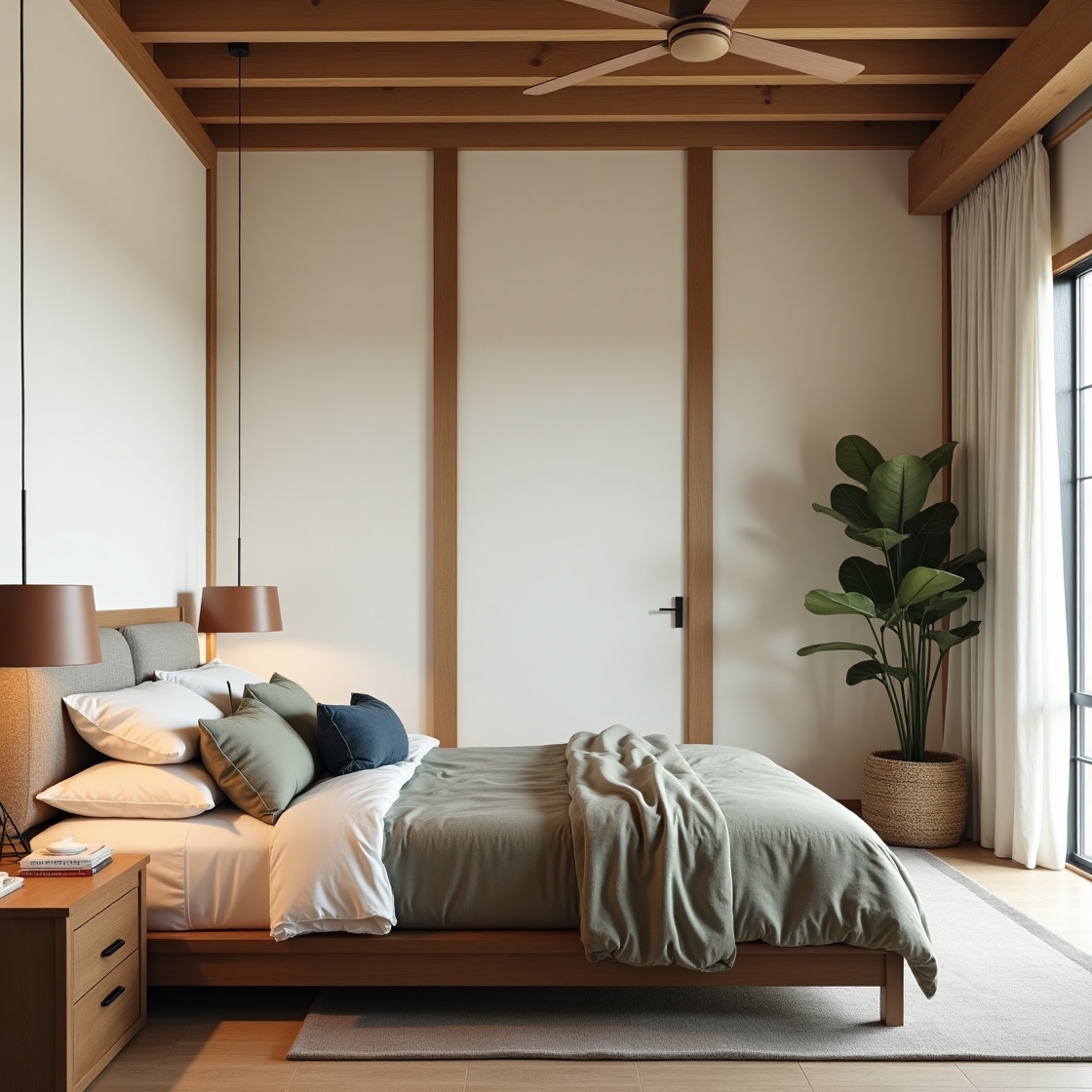How to Get the Japanese Feel at Your Home
Creating a Japanese-inspired home is not just about incorporating traditional elements—it is about embracing a philosophy that values simplicity, harmony, and a deep connection with nature. Japanese interiors are known for their calm and peaceful ambiance, making them a perfect retreat from the chaos of everyday life. If you want to bring the Japanese aesthetic into your home, here are seven key ideas to achieve that authentic feel.
1. Use Natural Materials

A serene Japanese-inspired living room set amidst the Australian landscape, blending seamlessly with its surroundings, featuring an abundance of natural materials, textures, and earthy tones. The room is adorned with traditional Shoji screens made of translucent washi paper, allowing soft, warm light to filter in, casting a gentle glow on the Tatami mats covering the floor. Elegant wooden furniture, boasting a raw, unfinished look, adds warmth and coziness to the space, while stone accents bring in an element of ruggedness. The walls are clad in natural wood panels, and the ceiling is made of woven bamboo, adding a sense of organic sophistication. The overall aesthetic is one of understated elegance, tranquility, and harmony with nature, evoking a sense of Zen-like calmness, perfect for relaxation and contemplation.
One of the most defining features of Japanese interiors is the use of natural materials. Wood, bamboo, stone, and paper are integral elements that create a warm and organic ambiance. Shoji screens, which are sliding doors made of wood and translucent paper, are a common feature in traditional Japanese homes. These screens allow soft, diffused light to enter the room, creating a tranquil atmosphere.
Tatami mats, made from woven straw, are another staple of Japanese interiors. They are commonly used as flooring in traditional rooms and add a natural, textured feel. You can incorporate tatami mats in specific areas, such as a meditation space or reading nook, to add an authentic touch.
To enhance the natural feel, consider using wooden furniture with a raw or unfinished look. Bamboo furniture, stone sinks, and wooden wall panels can further elevate the aesthetic. The key is to keep things as natural and organic as possible, avoiding synthetic materials that can disrupt the harmony of the space.
2. Minimalist Aesthetic
Minimalism is at the heart of Japanese interior design. Unlike Western interiors that may emphasize decoration and accessories, Japanese spaces prioritize simplicity and functionality. Every item in the home should serve a purpose, reducing clutter and creating a serene environment.
Start by decluttering your living space. Remove excess furniture and decorations, leaving only the essentials. Opt for sleek, low-profile furniture, such as low wooden tables and floor cushions. Storage solutions should be discreet and built-in wherever possible, maintaining clean lines and an open feel.
Japanese minimalism is also about balance. The concept of ma (negative space) plays a crucial role in design. Spaces should not be overcrowded; instead, they should have a harmonious balance between furniture, empty space, and natural elements. This creates an atmosphere of tranquillity and mindfulness, where every object has its place and purpose.
3. Soft, Neutral Colours
Colour plays a significant role in Japanese interior design. The palette is often inspired by nature, featuring shades of white, beige, soft grey, brown, and muted greens. These colours help to create a calming and harmonious environment.
Walls should be kept light and neutral, allowing natural elements like wooden beams or stone textures to stand out. If you want to add some contrast, consider using darker wooden furniture or accents in deep greens or blues. However, bright and bold colours are generally avoided in favour of subtlety.
Traditional Japanese homes often incorporate wabi-sabi, a philosophy that embraces imperfection and the beauty of aging materials. A slightly weathered wooden surface or textured wall in an earthy tone can enhance this aesthetic, adding depth and character to the space.
4. Incorporate Japanese Lighting
Lighting in Japanese interiors is designed to create a soft, ambient glow. Harsh overhead lights are avoided in favour of warm, indirect lighting that enhances the room’s tranquillity.
Paper lanterns, such as andon or chochin, are popular choices. These lamps are typically made from washi paper and emit a soft, warm glow that creates a cosy and inviting atmosphere. Shoji lamps, which have wooden frames covered with paper, also contribute to a gentle lighting effect.
Another way to incorporate Japanese lighting is through recessed lighting or floor lamps with diffused light. The goal is to create an environment that mimics natural daylight, promoting relaxation and comfort.
5. Bring Nature Indoors

Modern bathroom with Japanese feel, including bonsai trees and ikebana, bamboo plants, potted moss, and indoor rock gardens, and a small indoor water feature.
Nature is an essential component of Japanese design. The integration of plants, water features, and natural elements helps to create a connection with the outdoors, reinforcing a sense of peace and balance.
One of the simplest ways to bring nature indoors is through plants. Bonsai trees and ikebana (Japanese flower arrangements) are classic choices. Bonsai trees, with their carefully pruned branches, embody patience and mindfulness, while ikebana emphasizes asymmetry and natural beauty.
Bamboo plants, potted moss, and indoor rock gardens can also be used to add a natural touch. If space allows, consider incorporating a small indoor water feature, such as a tabletop fountain, to introduce the calming sound of flowing water.
Natural materials in furniture and decor, such as stone vases or wooden sculptures, further enhance this connection with nature. The key is to create a space that feels organic and grounded, reflecting the beauty of the natural world.
6. Create a Zen Space
A Japanese-inspired home should include a space dedicated to relaxation and mindfulness. This could be a meditation corner, a tea room, or a simple space for quiet reflection.
A Zen space typically includes a tatami mat, a floor cushion, and minimal décor. The focus is on simplicity and serenity, avoiding distractions that could disrupt the peaceful atmosphere. You might also incorporate a small Zen garden with sand and stones, which can be raked into patterns as a meditative practice.
Soft, ambient lighting and natural scents, such as sandalwood or lavender, can enhance the calming effect. A small altar or shelf with meaningful objects, such as a Buddha statue or a simple flower arrangement, can add a spiritual element to the space.
7. Japanese-Inspired Dining Area

Japanese-style dining room, using a chabudai, a low wooden dining table, surrounded by zabuton floor cushions, ceramic dishes, lacquerware bowls, and wooden chopsticks, a traditional cast iron teapot and ceramic tea cups. Keep the dining area uncluttered and elegant. A single flower arrangement, a simple table runner, or a hanging scroll (kakemono) with Japanese calligraphy.
The Japanese dining experience is centred around simplicity, tradition, and togetherness. To create an authentic Japanese-inspired dining area, consider using a chabudai, a low wooden dining table, surrounded by zabuton floor cushions instead of chairs.
Tableware plays a significant role in enhancing the experience. Choose ceramic dishes, lacquerware bowls, and wooden chopsticks to maintain authenticity. A traditional cast iron teapot and ceramic tea cups can complete the setup, allowing you to enjoy a Japanese tea ritual at home.
For décor, keep the dining area uncluttered and elegant. A single flower arrangement, a simple table runner, or a hanging scroll (kakemono) with Japanese calligraphy can add a refined touch without overwhelming the space.
Bring It All Together
Bringing the Japanese feel into your home is about more than just aesthetics—it is about embracing a lifestyle that values simplicity, harmony, and a connection with nature. By incorporating natural materials, a minimalist approach, soft lighting, and elements of nature, you can transform your living space into a tranquil sanctuary.
Whether you choose to create a Zen meditation space, integrate traditional Japanese furniture, or simply add a few natural touches, these ideas will help you cultivate a home environment that reflects the elegance and serenity of Japanese design. By thoughtfully curating your space, you can achieve a home that not only looks Japanese but also feels peaceful and harmonious, bringing a sense of calm to your everyday life.


